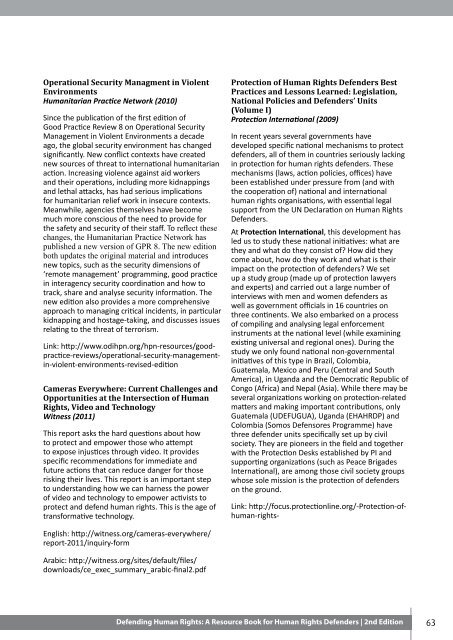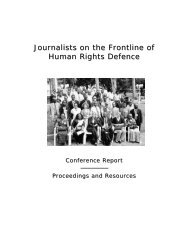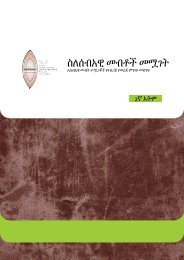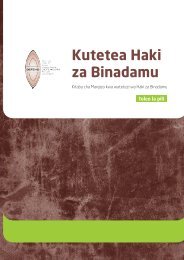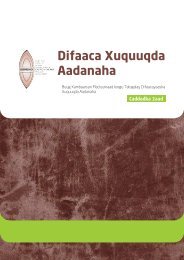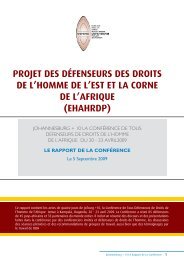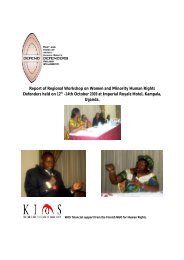Defending Human Rights: A Resource Book for Human
Defending Human Rights: A Resource Book for Human
Defending Human Rights: A Resource Book for Human
You also want an ePaper? Increase the reach of your titles
YUMPU automatically turns print PDFs into web optimized ePapers that Google loves.
Operational Security Managment in Violent<br />
Environments<br />
<strong>Human</strong>itarian Practice Network (2010)<br />
Since the publication of the first edition of<br />
Good Practice Review 8 on Operational Security<br />
Management in Violent Environments a decade<br />
ago, the global security environment has changed<br />
significantly. New conflict contexts have created<br />
new sources of threat to international humanitarian<br />
action. Increasing violence against aid workers<br />
and their operations, including more kidnappings<br />
and lethal attacks, has had serious implications<br />
<strong>for</strong> humanitarian relief work in insecure contexts.<br />
Meanwhile, agencies themselves have become<br />
much more conscious of the need to provide <strong>for</strong><br />
the safety and security of their staff. To reflect these<br />
changes, the <strong>Human</strong>itarian Practice Network has<br />
published a new version of GPR 8. The new edition<br />
both updates the original material and introduces<br />
new topics, such as the security dimensions of<br />
‘remote management’ programming, good practice<br />
in interagency security coordination and how to<br />
track, share and analyse security in<strong>for</strong>mation. The<br />
new edition also provides a more comprehensive<br />
approach to managing critical incidents, in particular<br />
kidnapping and hostage-taking, and discusses issues<br />
relating to the threat of terrorism.<br />
Link: http://www.odihpn.org/hpn-resources/goodpractice-reviews/operational-security-managementin-violent-environments-revised-edition<br />
Cameras Everywhere: Current Challenges and<br />
Opportunities at the Intersection of <strong>Human</strong><br />
<strong>Rights</strong>, Video and Technology<br />
Witness (2011)<br />
This report asks the hard questions about how<br />
to protect and empower those who attempt<br />
to expose injustices through video. It provides<br />
specific recommendations <strong>for</strong> immediate and<br />
future actions that can reduce danger <strong>for</strong> those<br />
risking their lives. This report is an important step<br />
to understanding how we can harness the power<br />
of video and technology to empower activists to<br />
protect and defend human rights. This is the age of<br />
trans<strong>for</strong>mative technology.<br />
Protection of <strong>Human</strong> <strong>Rights</strong> Defenders Best<br />
Practices and Lessons Learned: Legislation,<br />
National Policies and Defenders’ Units<br />
(Volume I)<br />
Protection International (2009)<br />
In recent years several governments have<br />
developed specific national mechanisms to protect<br />
defenders, all of them in countries seriously lacking<br />
in protection <strong>for</strong> human rights defenders. These<br />
mechanisms (laws, action policies, offices) have<br />
been established under pressure from (and with<br />
the cooperation of) national and international<br />
human rights organisations, with essential legal<br />
support from the UN Declaration on <strong>Human</strong> <strong>Rights</strong><br />
Defenders.<br />
At Protection International, this development has<br />
led us to study these national initiatives: what are<br />
they and what do they consist of How did they<br />
come about, how do they work and what is their<br />
impact on the protection of defenders We set<br />
up a study group (made up of protection lawyers<br />
and experts) and carried out a large number of<br />
interviews with men and women defenders as<br />
well as government officials in 16 countries on<br />
three continents. We also embarked on a process<br />
of compiling and analysing legal en<strong>for</strong>cement<br />
instruments at the national level (while examining<br />
existing universal and regional ones). During the<br />
study we only found national non-governmental<br />
initiatives of this type in Brazil, Colombia,<br />
Guatemala, Mexico and Peru (Central and South<br />
America), in Uganda and the Democratic Republic of<br />
Congo (Africa) and Nepal (Asia). While there may be<br />
several organizations working on protection-related<br />
matters and making important contributions, only<br />
Guatemala (UDEFUGUA), Uganda (EHAHRDP) and<br />
Colombia (Somos Defensores Programme) have<br />
three defender units specifically set up by civil<br />
society. They are pioneers in the field and together<br />
with the Protection Desks established by PI and<br />
supporting organizations (such as Peace Brigades<br />
International), are among those civil society groups<br />
whose sole mission is the protection of defenders<br />
on the ground.<br />
Link: http://focus.protectionline.org/-Protection-ofhuman-rights-<br />
English: http://witness.org/cameras-everywhere/<br />
report-2011/inquiry-<strong>for</strong>m<br />
Arabic: http://witness.org/sites/default/files/<br />
downloads/ce_exec_summary_arabic-final2.pdf<br />
<strong>Defending</strong> <strong>Human</strong> <strong>Rights</strong>: A <strong>Resource</strong> <strong>Book</strong> <strong>for</strong> <strong>Human</strong> <strong>Rights</strong> Defenders | 2nd Edition 63


